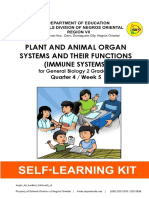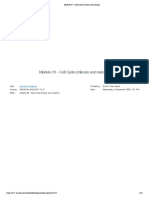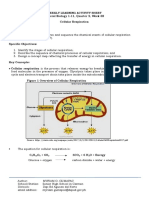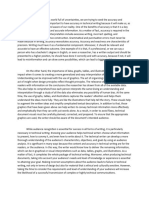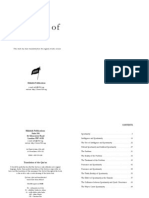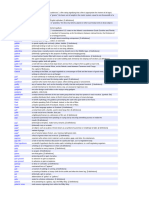Biology: Reproduction Plants Animals
Uploaded by
Sheene MariquinaBiology: Reproduction Plants Animals
Uploaded by
Sheene MariquinaBiology
Activity 1. R E P R O D U C T I O N
Reproduction Plants Animals
Can reproduce Yes, plants can reproduce Yes, animals can
asexually? asexually. reproduce asexually.
If yes, write the different The different ways on The different ways on how
ways on how they how plants reproduce animals reproduce asexually
is through parthenogenesis,
reproduce asexually. asexually is through
budding, fragmentation or
Explain and give an vegetative propagation binary fission.
example and fragmentation. Parthenogenesis is a form of
Vegetative propagation is reproduction in which an egg
where offspring grow can develop into an embryo
from a part of the parent without being fertilized by a
plant. An example of sperm. An example of
parthenogenesis is a bird.
vegetative propagation is
Another way is budding
true bulb which includes which is a small growth on
onion and garlic. And the surface of parent breaks off,
last way a plant can resulting in the formation of
reproduce asexually is two individuals and its
through fragmentation. example is yeast. Next is
fragmentation and it is where
Fragmentation is another
organisms break into two or
form of asexual more fragments that develop
reproduction that into a new individual. Or it
involves new plants can be binary fission where
growing from small parts single parent cell doubles its
of the parent plant that DNA, then divides into two
cells and usually occurs in
fall to the ground. And its
bacteria. An example of
example are liverworts fragmentation is starfish
and mosses. while an example of binary
fission is amoeba.
Reproduction Plants Animals
Can reproduce Yes, plants can Yes, animals can
sexually? reproduce sexually. reproduce sexually.
If yes, write the different There is only one way There is only one way
ways on how they on how plants on how animals can
reproduce sexually reproduce sexually produce sexually and
and that is through that is through
pollination. fertilization.
Pollination is the Fertilization is the
transfer of pollen fusion of haploid
from-flower-to-flower gametes, egg and
in angiosperms or sperm, to form the
cone-to-cone in diploid zygote and
gymnosperms. give birth to the
young ones.
Activity 2. Growth and Development
Directions. Read and analyze the statements below. Write TRUE
if the statement is correct and FALSE if otherwise. Write your
answer on a separate sheet of paper.
(F) 1. Animals have definite pattern of growth and
development while plants’ growth is limited
to a certain size.
(T) 2. The cells of plants and animals enable them to grow
and develop.
(T) 3. Both plants and animals’ growth are supported by
organs and organ systems.
(F) 4. Plants and animals have meristematic regions.
(F) 5. Plants and animals can grow throughout their life.
Activity 3. Mode of Nutrition
Directions. Read and analyze the statements below. Write TRUE
if the statement is correct and FALSE if otherwise. Write your
answer in your answer sheet.
(T) 1. Plants have the capability to make their own food
while animals cannot.
(T) 2. Both plants and animals obtain their food from
sunlight, water and air.
(T) 3. Plants are autotrophic while animals are
heterotrophic.
(T) 4. Animals depend on plants and other organisms for
food while plants rely on sunlight, water and air.
(F) 5. Plants and animals have presence of chlorophyll on
their cells.
Activity 4. Gas Exchange
Directions: Compare and contrast the process of gas exchange in plants
and animals. Copy and complete the table in your answer sheet.
Plants Animals
Take In/Inhales Carbon dioxide Oxygen
Releases/Exhales Oxygen Carbon dioxide
Organs/Structure Stomata is where the Lungs, gills, skin are
Used for Gas gases happened to the organs/structure
Exchange exchange that is used for gas
exchange.
Activity 5. Transport/Circulation
Directions. Read and analyze the statements below. Write TRUE if the
statement is correct and FALSE if otherwise. Write your answer on your
answer sheet.
(T) 1. Plants are less complex and requires less food and water to survive
while animals require more food and nutrients.
(F) 2. In animals, circulatory system is the main transport system in the body
while plants have vascular vessels.
(F) 3. Both plants and animals have capillaries to allow the flow of fluids
in their body.
(T) 4. Plants do translocation process while animals do the circulation process.
(T) 5. Plants have xylem and phloem to carry water, dissolved minerals to
different parts of the plant while animals have arteries and capillaries
that carries oxygen-rich blood throughout the body.
Activity 6. Regulation of Body Fluids
Directions. Read and analyze the statements below. Write TRUE if the
statement is correct and FALSE if otherwise. Write the answer on your
answer sheet.
TRUE FALSE
1. Vacuoles are structures in plants ……………………
that regulates cytoplasm osmolarity ……..
while animals have excretory
system that controls the amount of
water loss and maintains osmotic
pressure.
2. In animals, organs that are ……………………
responsible for osmoregulation …
depend on the species while plant
cells rely on vacuoles to regulate
cytoplasm osmolarity.
3. Osmoregulation in plants and …………
animals mainly depends on the …
water and salt absorbed in roots.
4. Plants that live in different …….
habitat have different ways on to
regulate water loss and absorption.
5. Osmoregulators like birds and ………….
mammals can keep the osmolarity
of body fluids different from their
environment while
osmoconformers like marine
invertebrates allow the osmolarity
of their body fluids to
match that of their environment.
Activity 7. Chemical and Nervous Control
Directions: Compare and contrast the chemical and
nervous control in plants and in animals. Copy and
complete the table on your answer sheet.
Chemical and Nervous
Control
Plants Animals
Presence of Plant hormones can Vertebrates have ductless
glands/ Endocrine glands
affect all aspects of plant
hormones life, from flowering to
that produces hormones.
While
fruit setting and
maturation, and from
phototropism to leaf fall.
Moreover, hormones are
signaling chemicals that
are present in tiny
amounts, distributed
throughout the plant
body, and only elicit
responses in cells that
have the appropriate
hormone receptors, just
as in animals.
Origin of hormones Every cell in a plant can Unlike plant
hormones, animal
produce plant hormones.
hormones are
Animal hormones are
often produced in
produced exclusively in specialized hormone-
specific glands. synthesizing glands.
Hormones control a wide The hormones are then
range of plant behaviors secreted from the
in response to various glands into the blood
stream, where they are
stimuli.
transported throughout
the body.
Structure that In plants, hormones The Endocrine and
nervous system
transports travel large coordinate with each
hormones throughout the body other through a series of
feedback mechanism.
via the vascular tissue Feedback mechanism A
(xylem and phloem) mechanism or a signal
that tends to initiate (or
and cell-to-cell via accelerate) or to inhibit
plasmodesmata. (or slow down) a process.
Hormones produced The hormones that are produced by
plants are: a) Auxin, the master growth Here are some of the Endocrine
and functions regulator; b) Cytokinin which is glands and hormones they
responsible for cell division; c) produced. a) Hypothalamus - the
Gibberellins responsible for stem, fruit, hormones from the hypothalamus
and seed growth; d) Abscisic Acid govern physiologic functions such
(ABA) that causes dormancy of the as temperature regulation, thirst,
plant; e) Ethylene, hunger, sleep, mood, sex drive,
promotes fruit ripening, flower wilting, and the release of other hormones
and leaf fall; f) Systemin, anti-herbivory within the body.; b) Anterior
hormone that activates plant responses Pituitary gland - Growth Hormone
to wounds from herbivores; g) Methyl (GH), stimulates growth,
Salicylate (MeSa), hormone for Adrenocorticotropic hormone
immunity that helps regulate responses. (ACTH), regulates levels of the
steroid hormone cortisol, which
released from the adrenal gland; c)
Parathyroid gland , Parathyroid
Hormone, increases blood 𝑪𝒂 𝟐+;
d) Thyroid gland – produces
thyroxine that increases metabolic
rate and heart rate; promotes
growth; e) Adrenal glands –
Epinephrine, produces many
effects related to short- term stress
response, Cortisol, produces many
effects related to short-term and
long-term responses, Aldosterone,
increases reabsorption of 𝑁𝑎+ by
kidneys; f) Pancreas - Islets of
Langerhans Insulin, decreases
blood glucose, Glucagon,
increases blood glucose Kidneys,
Erythropoietin (EPO), increases
synthesis of red blood cells
Vitamin D and decreases blood
𝐶𝑎2+; g) Ovaries – Estradiol,
regulates development and
maintenance of secondary sex
characteristics in females; other
effects; Progesterone-
prepares uterus for
pregnancy; h) Testes –
testosterone, regulates
development and
maintenance of secondary
sex characteristics in
males;
Presence of Plants don’t have a All animals have a true
presence of nervous nervous system except
Nervous System system. However, it has sea sponges.
plant hormones that
affect all aspects of plant
life.
Plants don’t have a
Basic structure basic structure since While there is great
diversity among
it has no presence of different vertebrate.
nervous system. a CNS that contains
a brain and spinal
cord and a PNS
made up of
peripheral sensory
and motor nerves.
Location NONE One interesting
difference between the
nervous systems of
invertebrates and
vertebrates is that the
nerve cords of many
invertebrates are
located ventrally (along
the belly) whereas the
vertebrate spinal cords
are located dorsally
(along the back).
Activity 8. Immune System
Directions. Read and analyze the statements below. Write TRUE if the
statement is correct and FALSE if otherwise. Write the answer on your
answer sheet.
TRUE 1. Plants have Methyl Salicylate hormone that
helps regulate responses to infection by parasites or
pathogens while animals have a complex immune
system that recognize foreign substances in the
body and destroy them.
FALSE 2. Plants use hormones to fight infection while
animals use a complex network of organs
containing cells to fight against diseases.
TRUE 3. Plants and animals have their own special way
in fighting pathogens, viruses, bacteria and other
parasites that penetrates into the organism.
TRUE 4. Plants: two branched innate immune system;
Animals advanced immune system
FALSE 5. Molecular/substance recognition has significant
role in the immunity of plants and animals.
You might also like
- Plants E. Spore Formation F. Does Not Involve Gametes Animals B. Sexual Selection D. Involves Sperm and Egg CellNo ratings yetPlants E. Spore Formation F. Does Not Involve Gametes Animals B. Sexual Selection D. Involves Sperm and Egg Cell5 pages
- Lesson 13: Evolutionary Relationship of OrganismNo ratings yetLesson 13: Evolutionary Relationship of Organism13 pages
- General Biology 2: Investigative Files: Into The Depths of EvolutionNo ratings yetGeneral Biology 2: Investigative Files: Into The Depths of Evolution29 pages
- Genbio 2 Mod12.1 Reproduction DevelopmentNo ratings yetGenbio 2 Mod12.1 Reproduction Development28 pages
- Genbio 2 Module 1 Genetic Engineering ProcessNo ratings yetGenbio 2 Module 1 Genetic Engineering Process26 pages
- Genbio2 q4 SLM 1 Animal and Plant ReproductionNo ratings yetGenbio2 q4 SLM 1 Animal and Plant Reproduction24 pages
- Genbio 2 Mod14 Regulation of Body Fluids FinalNo ratings yetGenbio 2 Mod14 Regulation of Body Fluids Final35 pages
- General Biology 2: Quarter 4: Week 2 - Module 1B PNo ratings yetGeneral Biology 2: Quarter 4: Week 2 - Module 1B P26 pages
- GenPhys1 12 Q2 Mod6 TemperatureandHeat Ver4-1No ratings yetGenPhys1 12 Q2 Mod6 TemperatureandHeat Ver4-127 pages
- Clariz C. Oña Stem11b Osmosis ExperimentNo ratings yetClariz C. Oña Stem11b Osmosis Experiment8 pages
- General Chemistry 1 Activity Sheet Quarter 2-MELC 12 Week 6No ratings yetGeneral Chemistry 1 Activity Sheet Quarter 2-MELC 12 Week 69 pages
- General Biology 2: Quarter 1-Module 1: Genetic Engineering and Recombinant DNA TechnologyNo ratings yetGeneral Biology 2: Quarter 1-Module 1: Genetic Engineering and Recombinant DNA Technology31 pages
- Plant Reproduction and Development: Lesson 8.1100% (1)Plant Reproduction and Development: Lesson 8.122 pages
- Maintaining Steady Internal Conditions of Organisms100% (1)Maintaining Steady Internal Conditions of Organisms43 pages
- General Biology 2: Mechanisms of Change in PopulationNo ratings yetGeneral Biology 2: Mechanisms of Change in Population22 pages
- General Biology 2: Quarter 1 - Module 1: Recombinant DNANo ratings yetGeneral Biology 2: Quarter 1 - Module 1: Recombinant DNA28 pages
- Plant and Animal Chemical and Nervous Control100% (2)Plant and Animal Chemical and Nervous Control27 pages
- GB2 LAS Q3 W7A Bases of Bio ClassificationNo ratings yetGB2 LAS Q3 W7A Bases of Bio Classification9 pages
- GENBIO2 MOD9 The Explaination Behind Every Transformation.No ratings yetGENBIO2 MOD9 The Explaination Behind Every Transformation.22 pages
- General Biology 2: Quarter 3, Module 1 Genetic EngineeringNo ratings yetGeneral Biology 2: Quarter 3, Module 1 Genetic Engineering20 pages
- Module #3 - Cell Cycle (Mitosis and Meiosis)No ratings yetModule #3 - Cell Cycle (Mitosis and Meiosis)34 pages
- General Biology 2: Evolutionary ThoughtsNo ratings yetGeneral Biology 2: Evolutionary Thoughts13 pages
- Unit 4 Compare and Contrast Process in Plants and Animals: Nutrient Procurement and ProcessingNo ratings yetUnit 4 Compare and Contrast Process in Plants and Animals: Nutrient Procurement and Processing8 pages
- The Role of ATP in Energy Coupling ModuleNo ratings yetThe Role of ATP in Energy Coupling Module15 pages
- General Biology 2: Quarter 4: Week 2 - Module 1B P100% (2)General Biology 2: Quarter 4: Week 2 - Module 1B P25 pages
- Senior Gen Biology2 Q3 - M2 - L2 For PrintingNo ratings yetSenior Gen Biology2 Q3 - M2 - L2 For Printing19 pages
- Individual Worksheet - Reproduction in Plants and AnimalsNo ratings yetIndividual Worksheet - Reproduction in Plants and Animals3 pages
- Milktea Ko Thanks Nami Dad Kung May Burger CharrNo ratings yetMilktea Ko Thanks Nami Dad Kung May Burger Charr6 pages
- 100 Important Terminologies in Medical Surgical Nursing50% (2)100 Important Terminologies in Medical Surgical Nursing4 pages
- What Philosophy Says About The Self (Notes) PDFNo ratings yetWhat Philosophy Says About The Self (Notes) PDF23 pages
- Complex Analysis: Chapter V. Singularities V.1. Classification of Singularities-Proofs of TheoremsNo ratings yetComplex Analysis: Chapter V. Singularities V.1. Classification of Singularities-Proofs of Theorems23 pages
- Students' Reasoning in Fluid Dynamics: Bernoulli'S Principle vs. The Continuity EquationNo ratings yetStudents' Reasoning in Fluid Dynamics: Bernoulli'S Principle vs. The Continuity Equation8 pages
- Constitutional Design Question and AnswersNo ratings yetConstitutional Design Question and Answers2 pages
- Generalized Duality Mapping: Journal of The Indian Mathematical Society January 2015No ratings yetGeneralized Duality Mapping: Journal of The Indian Mathematical Society January 201516 pages
- The Mammoth Book of The World S Greatest Chess Games by Graham Burgess DR John Nunn and John EmmsNo ratings yetThe Mammoth Book of The World S Greatest Chess Games by Graham Burgess DR John Nunn and John Emms25 pages
- Primavera Training - V 16.1 BU - Sep 2016 PDFNo ratings yetPrimavera Training - V 16.1 BU - Sep 2016 PDF464 pages
- Plants E. Spore Formation F. Does Not Involve Gametes Animals B. Sexual Selection D. Involves Sperm and Egg CellPlants E. Spore Formation F. Does Not Involve Gametes Animals B. Sexual Selection D. Involves Sperm and Egg Cell
- General Biology 2: Investigative Files: Into The Depths of EvolutionGeneral Biology 2: Investigative Files: Into The Depths of Evolution
- General Biology 2: Quarter 4: Week 2 - Module 1B PGeneral Biology 2: Quarter 4: Week 2 - Module 1B P
- General Chemistry 1 Activity Sheet Quarter 2-MELC 12 Week 6General Chemistry 1 Activity Sheet Quarter 2-MELC 12 Week 6
- General Biology 2: Quarter 1-Module 1: Genetic Engineering and Recombinant DNA TechnologyGeneral Biology 2: Quarter 1-Module 1: Genetic Engineering and Recombinant DNA Technology
- Maintaining Steady Internal Conditions of OrganismsMaintaining Steady Internal Conditions of Organisms
- General Biology 2: Mechanisms of Change in PopulationGeneral Biology 2: Mechanisms of Change in Population
- General Biology 2: Quarter 1 - Module 1: Recombinant DNAGeneral Biology 2: Quarter 1 - Module 1: Recombinant DNA
- GENBIO2 MOD9 The Explaination Behind Every Transformation.GENBIO2 MOD9 The Explaination Behind Every Transformation.
- General Biology 2: Quarter 3, Module 1 Genetic EngineeringGeneral Biology 2: Quarter 3, Module 1 Genetic Engineering
- Unit 4 Compare and Contrast Process in Plants and Animals: Nutrient Procurement and ProcessingUnit 4 Compare and Contrast Process in Plants and Animals: Nutrient Procurement and Processing
- General Biology 2: Quarter 4: Week 2 - Module 1B PGeneral Biology 2: Quarter 4: Week 2 - Module 1B P
- Individual Worksheet - Reproduction in Plants and AnimalsIndividual Worksheet - Reproduction in Plants and Animals
- 100 Important Terminologies in Medical Surgical Nursing100 Important Terminologies in Medical Surgical Nursing
- Complex Analysis: Chapter V. Singularities V.1. Classification of Singularities-Proofs of TheoremsComplex Analysis: Chapter V. Singularities V.1. Classification of Singularities-Proofs of Theorems
- Students' Reasoning in Fluid Dynamics: Bernoulli'S Principle vs. The Continuity EquationStudents' Reasoning in Fluid Dynamics: Bernoulli'S Principle vs. The Continuity Equation
- Generalized Duality Mapping: Journal of The Indian Mathematical Society January 2015Generalized Duality Mapping: Journal of The Indian Mathematical Society January 2015
- The Mammoth Book of The World S Greatest Chess Games by Graham Burgess DR John Nunn and John EmmsThe Mammoth Book of The World S Greatest Chess Games by Graham Burgess DR John Nunn and John Emms












